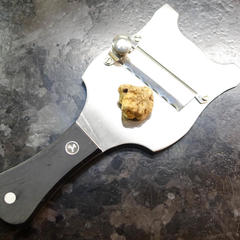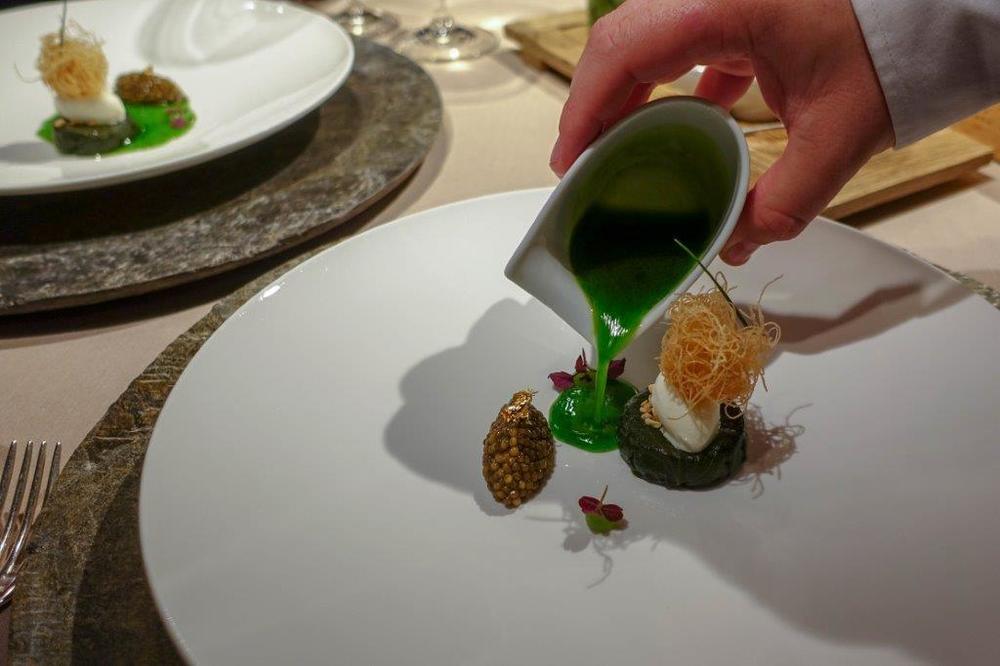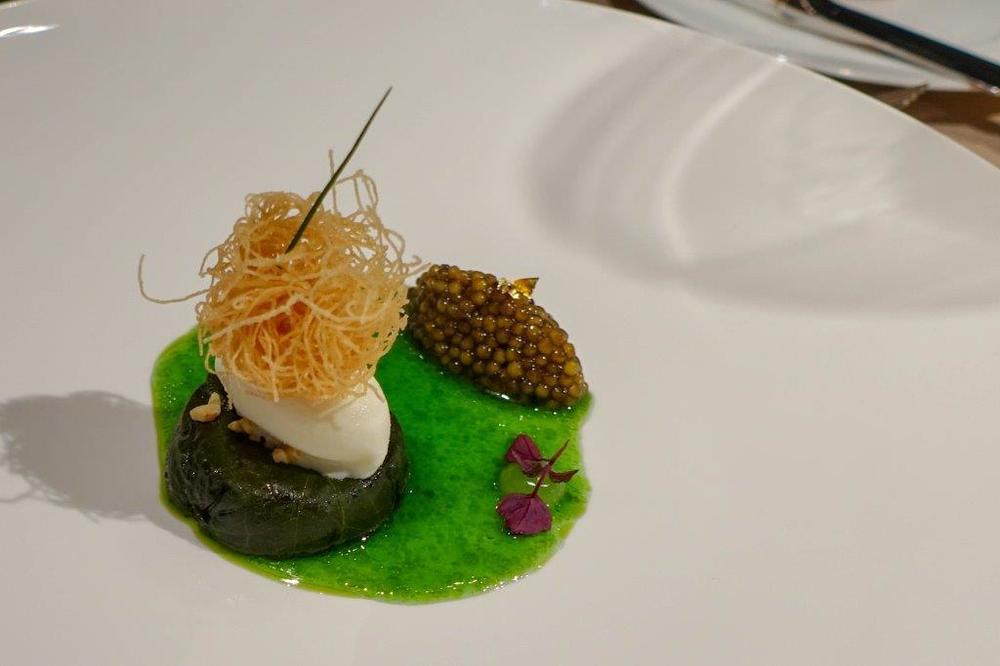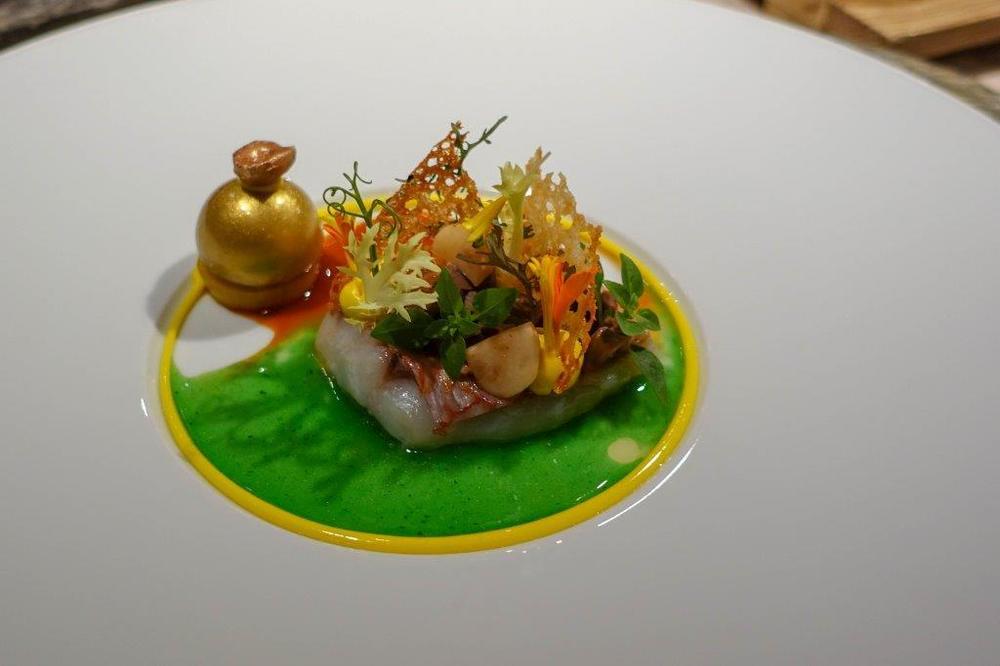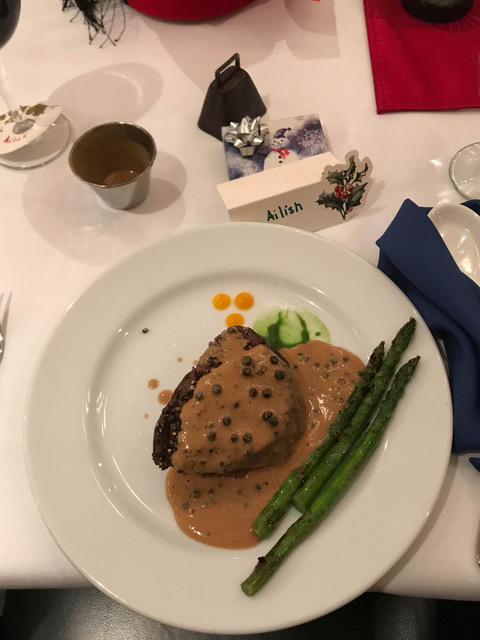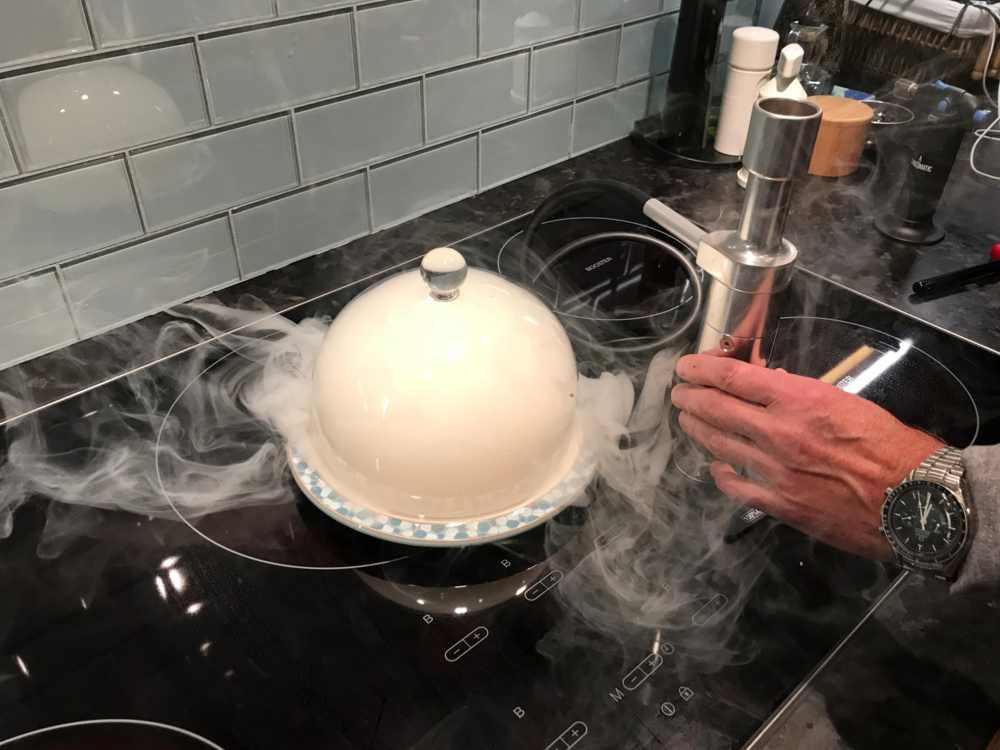-
Posts
48 -
Joined
-
Last visited
Content Type
Profiles
Forums
Store
Help Articles
Everything posted by Tuber magnatum
-
I just hosted a dinner party and served a stuffed glove deboned quail. Deboning was a pain but if I say so, the finished product was delicious (links below for those interested in how). The quail was pan seared and finished in the oven, ie pan roasted, which I did a la minute smoking up the kitchen and dining area! So ... if I were to do this again, could I "pre-sear" the quail in advance before guests arrive and just finish the roasting part a la minute so less smoke and less time away from quests? My worry was that the skin would get limp and not re-crisp in the oven. (Also how to deal with it once seared; refrigerate, bring back to room temperature?) Curious how those in the restaurant biz might partially cook skin on poultry before service. I served with a demiglace made from the bones which was plated table side on bed of wild rice and spinach. (For those interested, this is recipe I used: https://www.dartagnan.com/roasted-quail-stuffed-with-fig-and-prosciutto-recipe.html and for the glove deboning technique:
-
I have been experimenting with reverse spherification with some success. I would like to try and "elevate" the technique and wondered if any one had tried colouring and / or adding flavour to the sodium alginate bath. I was thinking that would enhance the overall flavour and visual appeal. I know that with indirect spherification you can mix the flavourful liquid with the sodium alginate, but I'm wanting to keep the inside liquid so need to do reverse spherification. Does adding anything to the sodium alginate bath effect its gelling properties? I am curious that I haven't come across any recipes which suggest adding colour / flavour to the bath as that seems like a no brainer as otherwise the gel coating is kind of bland. I was wondering if that is because it doesn't gel properly when the Calcium doped flavourful liquid is dropped in.
-
My birthday and XMAS both fall in the month of December, and typically I buy my own gifts and give to the kids / wife to wrap! This year I was looking at the two Madison Park cookbooks: "Eleven Madison Park: The Cookbook" vs "Eleven Madison Park: The Next Chapter, Revised and Unlimited Edition". Has anyone seen both to help me decide which of the two to get first? Are they sufficiently different that it might be worth getting both? And lastly the revised single volume "Next" cookbook I see from the description has 80 recipes whereas I believe the limited two volume signed edition had 100. Are the 80 chosen from the 100? Are the 20 "missing" recipes worth having? Thanks in advance!
-
Hello, I have been reading this topic with great interest. Now that there are several owners / users of the Anova Steam Oven, I wonder if a consensus has been reached re the utility. What I am really asking is, Santa has requested my list and I would like to know it I should consider this as my big gift. (To be totally up front, I buy my own gifts and give them to either my wife or kids to wrap and give me!)
-
Not sure what others mean by "bloody on the bone", but if they mean pink, the poultry could just as easily have been overcooked as under. The pink as I understand it can result from purple marrow which leaks from bone (especially from young birds typically found in stores which have more porous bone) and stains adjacent meat which will not fade regardless of temperature. Also from what I have read in Modernist Cuisine, cytochromes at a temperature of 80°C / 175°F loses ability to bind oxygen and turns pink. If you put the chicken in the fridge, the pink from the cytochromes rebind oxygen and pink decreases. Myoglobin is also pink and while it will turn clear with cooking, the temperature at which it does is variable so it can not be used as a measure of doneness. Bottom line, don't worry about the pink, worry about the temperature!
-
Thanks for your thoughts. You are correct; he was simply prehydrating. I had asked him how he managed to create such a nice texture as in my experience I could never adequately hydrate the Xanthan. That's when he wrote out the ratio to create the Xanthan goop. What he would then do was take a small amount of the "goop" ie prehydrated xanthan gum and add to the liquid to reach the desired consistency. I think you can get a sense of the consistency he was achieving with the addition of a small amount of the goop from my pictures above. It wasn't snotty at all, although I have on too many occasions over thickened sauce with xanthan. But even prehydrated, I have had difficulty incorporating the xanthan goop into the liquid to achieve a smooth texture. As for the green, I was hoping I wouldn't have to wait for St. Patricks Day to get a Shamrock Shake if you think that is the secret to the green! Surely there is another option?
-
Thanks for suggestion! Will read MC of course, but I found one new copy of this book at Amazon on sale... couldn't resist! Should arrive by Feb. 1st.
-
I have to admit ignorance on this and had to google it! Is this what you are talking about? https://en.wikipedia.org/wiki/Homogenizer. Looks like a very cool device. Do you have a specific one you like that is appropriate for the kitchen? Mechanical or sonic?
-
Maybe you can share some of your blends ratios and when / how you use them? I was going to actually create another topic on the subject of blending and using hydrocolloids, but since you brought it up here: Despite reading on-line resources including the excellent Kyhmos recipe collection ( https://blog.khymos.org/recipe-collection/ ) and Dave Arnold's hydrocolloid primer ( http://www.cookingissues.com/index.html%3Fp=1247.html ) I remain confused because it seems you can use multiple agents alone or in combination to create different or the same textures. I haven't gotten to the section in Modernist Cuisine on Hydrocolloids (trying to read all 5 volumes in order and am only part way through V3!) so maybe some help there, but I would love it if there was a chart that rather than listing the Hydrocolloid and what it does, the chart list the effect one wants to achieve and then the agents needed to create it. For example, Stabilize sorbet - use xxx, Thicken cold sauce - use yyy, Create liquid filled spheres - use aaa + bbb. etc. rather than having to read through all the hydrocolloids as in xxx- used to stabilize sorbet, yyy - used to thicken cold sauce, aaa - can be used with bbb, bbb - can be used with aaa. Hopefully you get the idea and it isn't dumb or I have missed some resource that already does this! Lastly, I have lots of individual hydrocolloids sitting in my larder, but I keep coming across recipes that will call for a specific brand, e.g. Sosa Vege Gel (carrageenan, carob, etc.) and it would be nice to just blend your own!
-
I am very fortunate to have a vacuum chamber which I have used for this very purpose. Haven't quite figured out best way to do so though. Do you like to create vacuum and when liquid about to boil over immediately release vacuum, or do you hold it at that low pressure for a time then release vacuum? Regardless of the two methods, do you do a fast release of vacuum or slow? Or does it matter as long as you don't boil liquid over creating mess in chamber?!
-
Largely because starches can effect flavour and clarity. As well hydrocolloids have other properties one can make use of, e.g. forming different types of gels etc. https://www.cooksillustrated.com/science/859-articles/story/word-of-the-week-hydrocolloid
-
Thanks. I was thinking the same thing about the particles in suspension. I was amazed though at the vibrancy of green and was wondering what he used. As for the stick blender or vita mix, I usually don't have enough volume to make those particularly effective, which was why I was so hopeful the pre hydrated xanthan would allow me to more easily incorporate it into a small volume of liquid. I guess I just need to be more aggressive with a hand whisk?
-
Thanks for the info. Can I ask, is the pre-hydrated ratio the same, 640ml of water mixed with 27gms xanthan? And how small / big amount of "goop" would you use for example with 250ml of liquid? Also, does heating help?
-
Hello, I had the opportunity of dining in Munich at Chef Jan Hartwig's three star Michelin restaurant Atelier. The food was delicious and the plating gorgeous. Several of the dishes made use of a "sauce" poured at table side which I have been trying to recreate. I have attached photos of two of these dishes. Unfortunately I cant for the life of me remember the flavor profile (too much wine maybe and too long ago?) but I was hoping some help might be forthcoming from all of you! I asked chef how he created the viscosity and he indicated xanthan gum to which I replied I always had difficulty hydrating it. He shared his secret; hydrate in advance and add to the liquid. He says he uses 640ml of water mixed with 27gms xanthan. This can be stored in the fridge until needed. You then take some of this gloop (at least that what I ended up with!) and add to your base liquid. Questions: 1) Has anyone tried this pre-hydration of xanthan and if so, how do you use it? Best way to mix? How much to use? etc. As noted, I ended up with a goop that was just as hard to disperse in my liquid as just using powdered xanthan. 2) Any ideas as to what the "green" is in either of the two dishes? He makes use of it frequently in other platingsI have seen he posts on his instagram and his facebook pages (Jan Hartwig - Restaurant Atelier, München). 3) What are or causes the "speckles" in the two different green sauces? Thanks in advance!
-
Just measured: Bottom of chest freezer exactly -20C / -4F
-
Thanks for noticing. I think I mistyped and meant Centigrade! -20C = -4F -22C = -7.6F So if home freezer -18C / 0F, that would make Pacojet use in a home environment problematic if the temperatures I understand are required are correct.
-
Does anyone have experience with using a Pacojet in the home? I may have access to one, and while I appreciate it would be very difficult to justify based on cost, I nevertheless am debating its practical value in a home environment cost aside. Questions I have are: Is its real value primarily as an icecream maker or are there other practical uses? I have read various concerns re whether home freezers are cold enough to sufficiently freeze cannisters, particularly as regards ending up with "slushy" icecream. ( I have read a number of temperatures, but I think consensus is -22F is the recommended range while home freezers are typically -20F). Not so much of an issue if final product not to be served frozen. Icecream recipes need to be modified? Just how noisy? Is Pacojet 2 worth the extra cost over version 1? Aside from icecream and gelatos, I was thinking it would be useful to have frozen stock which then could be individually portioned for making pan sauces etc. with out having to have multiple small frozen containers or having to partially thaw larger portions. Same for soups. Interested in how others have made use of it at home. Thanks in advance!
-
Thanks! Will try next time I get some quail eggs and let you know what I think!
-
Sounds interesting! Have a recipe for this to share?
-
Thank you for suggestion! I have read about that technique and using gels as well, but I think not having done it before and feeling a bit overwhelmed with new techniques as it was, I just let it sit! Admittedly, freezing something and letting it thaw is't that complex... next time though, assuming I ever want to see a quail egg again!
-
They are a reverse spherification passion fruit "yolk" with a "white" of lemon grass thickened with locust bean and xanthan gum. I first heard about these from a video featuring chef Anjana Shanker from the kitchen at Modernist Cuisine. The recipe wasn't fully explained but I later came across it here: https://www.chefsteps.com/activities/unreal-quail-egg Rather than use scissors to cut the tops off the quail eggs, I used "quail egg scissors" which do a perfect and very quick job. They cost about $3 dollars on Amazon.com. Also, as I of course don't have a centrifuge to clarify the lemon grass, I just let it sit in the fridge for a couple of days for the fine particulate matter to settle) and then carefully decanted it into a coffee filter. While my guests enjoyed the "unreal eggs", I have been eating fried and scrambled real quail eggs for the last week!
-
Greetings! I hope everyone's holiday season is going well. For those interested in how I solved my pepper steak for a crowd: 25 6-8oz filets, salted just before bagging, sous vide 130F x 2hrs. On removing from bag pat dried with paper towel but I tried experimenting with drying with heat gun (I know, controversial but thought I would try. Have also tried on chicken and seems to work better as the steak had a lot of juice). Steak then very lightly coated with mayo which I read somewhere improves maillard reaction (it certainly did!), seared on Tuscan grill (used lump charcoal in fireplace), coated with coarse black pepper, and served with green peppercorn sauce in individual 2oz sauce cups rather than added to plate so didn't run all over the place. The sauce which I was worried about and was focus of original question solved as follows: Morning of dinner shallots sautéed, cognac added and cooked au sec, veal stock added and reduced to a demi glace. Both demi glace and the shallots then pureed with 0.1% xanthan gum (not sure if necessary, but was worried that sauce would break using half and half rather than full cream even though I would later add dijon mustard both for flavour and emulsification) and passed through fine drum sieve and set aside till service. At service, half and half with the mustard blended in and warmed with green peppercorns and seasoned. Ratio of veal stock to cream I would guess 1:2. The sauce was a huge hit and didn't break. Plated with grilled asparagus, watercress / pea and squash purée. Steak garnished with sprig of watercress. Starch was ciabatta sliced, cut side lightly coated with EVOO, grilled and seasoned with truffle salt. Ciabatta also worked well as the Italians call it, "scarpetta" (slipper in English) to sop up sauce! Asparagus blanched in advance and grilled at service. (Got help from family with grilling the bread and asparagus while I seared the steaks and plated) As a pre desert and which was actually the most time consuming and difficult part of the meal (aside from the planning and worrying!) were the "Unreal Quail Eggs" of which I made 60. Fooled a lot of people with those but a LOT of work!
-
Advice sought re SV pepper Steak for Crowd. I have been tasked with hosting family XMAS dinner and will be serving 24+ people. Request was made for pepper steak. Normally I do a traditional treatment: season filet with very course black pepper, pan sear in clarified butter, flambe, remove steak, make sauce with cream, small amount dijon, and of course green peppercorns. My idea was to avoid any timing issues and having to sear multiple steaks on the stove, to SV them all in advance and for fun, rather than sear on gas grill or pan, to try and sear them on a Tuscan Grill that I have set up in my fire place. The fireplace is open on all sides located in the kitchen dining area. Grill is big enough to hold probably 8-12 steaks at a time. Pepper sauce made in advance and served restaurant style in "gravy boat". My questions are: 1) Should I still use coarse pepper before placing in bags? I have read different views on whether you should use pepper in SV bag as this can create some off flavours. And whether I put pepper on pre or post SV, should I be concerned that searing on an open flame I will just burn the pepper? (This has never been an issue when pan searing traditional style in clarified butter). 2) How concerned should I be making pepper sauce without having the scrapings or juices from pan searing as I wasn't planning on pre searing before placing in SV bag. Should I use the juices from the bags (with or without reducing depending on volume produced) and add to pre-made cream based pepper sauce? 3) I have seared SV steak on gas grill which I can get very hot, so nice crust and Maillard reaction. Do you think I will be able to get bed of charcoal hot enough to sear SV steak? Below is set up I use so you can see what I am talking about re Tuscan Grill where I was cooking some thin sliders from raw, ie not SV in advance. Hopefully there are some caterers out there with suggestions! Thanks in advance.
-
OK, I know this is not really smoking, but I have had some good success with just smoking thinly sliced cheese under a glass dome and allowing it to sit a few minutes. Applewood seems to work best for cheese. I have found the hickory and mesquite a little overpowering. Admittedly it is more for show, but when you open the dome at the table and a waft of smoke pours out, it always brings a smile, and occasionally a cough from our guests. 😋
-
Hello crustacean lovers! I have read and viewed videos on cryo-shucking oysters and reference to using the technique for other bivalves which makes sense. If not familiar, you basically drop oyster in Liquid Nitrogen for 15 seconds, remove and let rest 30 minutes. They will open up a bit allowing shell to be removed with out damage to shell or oyster. It is described in pod cast by Chef Anjana Shanker of the Modernist Cuisine Lab and in attached video. Partway through her description she comments on its use for lobster but doesn't describe the process. The closest instruction I have found is https://modernistcuisine.com/2014/07/cooking-for-ferran-adria-reflecting-on-inspiration-and-innovation/ but it isn't clear exactly how it is done. Drop whole lobster in N2? Just claw or tail? How then do you remove shell? Has any one tried this and how specifically do you do it? Thanks in advance!


